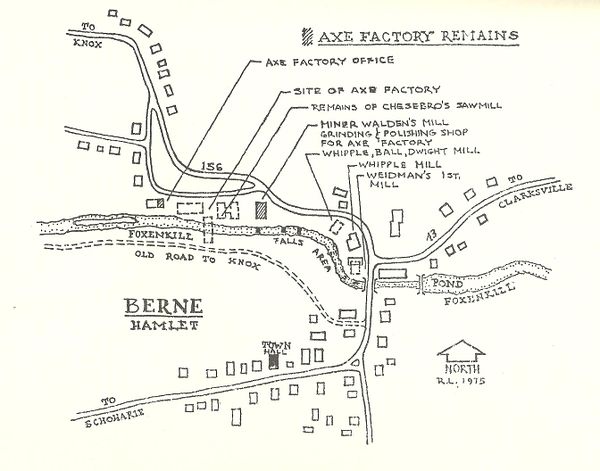Whipple, Ball, Dwight Mill
In the 1830's a carding and fulling mill was built by Malachi Whipple (1770-1836) along with William Ball (1791-1875) and Lyman Dwight (1797-1881).[1]

1975 map by Robert Lambert, from Our Heritage
Memoirs of Berne
My Dear Enterprise:
In 1845 and for some years after that uncle William Ball owned and operated a fulling mill, as it was called, just below the present upper grist mill, it took its water for power from the tail race of the grist mill. On the first floor was a wool receiving and cloth carding room where the farmers delivered their wool to be made into rolls, or the home spun cloth to be shrunken and carded. Around this room was usually bundles of wool done in cloth pinned with stout thorns from the thorn apple tree, each marked with the owner's name and the required rolls to be returned. In the rear on the same floor was a picking machine that picked the wool apart and tossed it out on a huge blanket, three carding machines that separated the wool into a gauze like film and a final one that turned the wool out in long rolls for the spinner; the picker mixed the wool of the black sheep with the white and made it gray, or mixed wool dyed blue with white to form the usual blue-gray, that was used for knitting. The black wool and the mixed black-gray was used in making home spun cloth making a dark brown or brown gray cloth, much used for clothing.
Down stairs In the basement was two washing machines in which flannel and wool were washed, (scoured). Around the walls of this basement was a big trough made out of the trunk of a tree that usually was full of home made soft soap, that was liberally used in the washers. After the wool was washed it was taken up stairs and generously oiled with lard oil that also made that floor very oily and slippery. In the front room on frames the home made cloth was stretched, carded, sponged and pressed, the flannels were stretched and dried on frames on the fence on the opposite side of the way some times extending from the mill shed to the hotel barn. Robert Adams was the foreman, and he and Wm. Miner ran the carders and roll machine. Daniel Adams ran the picker and William Adams the scourers and washers down stairs, (this was about 1850).
Mr. Adams in my early recollections lived in a house just west of what was later E. V. Filkins' law office. Danny had a beautiful spotted pussy he called Dodo, and a cossett lamb that usually came without calling getting very demonstrative as it grew older. Dan had a nice red hand sleigh, a pair of skates and played on an accordion quite well. He was an industrious boy who dressed well; and was respectful and obedient to his mother who was as good a woman as ever lived. We had our boyish squabbles and disagreements but take him all in all he was a fine manly fellow.
Speaking of the flannel stretchers in the fence opposite the old fulling mill they consisted of two long pieces of scantling one top and one bottom between two posts arranged so they could be pegged apart or together as the width of the goods to be dried demanded each having about every two inches a stout iron book about the size of a small nail driven in on the out-side that turned up in the top bar and down in the lower one on which the cloth was hooked and then the bar was raised to taughten the cloth and pinned there. When not in use they were usually about half way down or about four feet apart, and about two feet from the stout fence that was be hind them, then there was a bank up which led into an orchard that belonged to the miller. An empty cellar there indicated that a house had been burned.
There was a tree in that orchard that bore nice harvest apples. About those days there was a plaid cotton clotb on the market from which the fond mothers made trousers for their male offspring: encased in a pair of these made with the wise idea that I could grow to fit them, the waist band brought well up under my arms, leaving quite some material to turn up at the bottom of each leg, a a stout pair of tow cloth, home made suspenders and a muslin shirt completed the outfit. With several other honest men's sons, I had been under tbat apple tree and had hurriedly stuffed my pockets with apples, the cry that the miller was coming started us out. We went in by Paul Hochstrasser's front gate, we went out down the bank and over the fence, at least some did but having on a pair of boots and being some what clumsy I just slid over the stretching bar and as I went down on the outside my good stout new plaid pants caught by the main sail and my short legs failed to reach the lower bar so I just swung back against the fence with my heels and hung there head down. Uncle William saw me and didn't he laugh. He came and helped me down but he done it so energetically that I had no apples left. I meekly took a lecture from Mr. Adams, begged him not to tell any one about the matter, particularly the miller and went home. I didn't want the apples any way after what had happened. Mr. Adams said something that sounded like "trying to hook apples and getting hooked yourself."
Respectfully, T. Emmett Willard. Brooklyn, 164 Albany Ave. Source:[2]
Sources
1.↑ Our Heritage article by Robert Lambert
2.↑ Altamont Enterprise, 16 Aug 1901